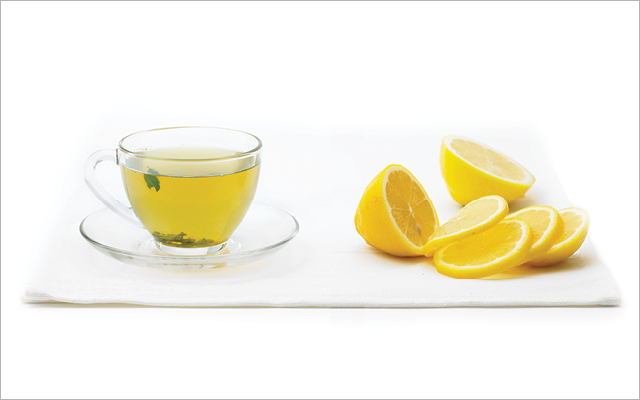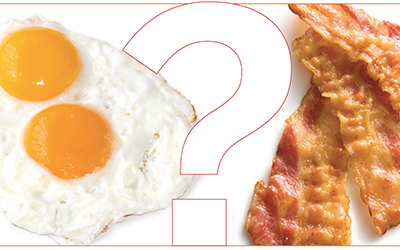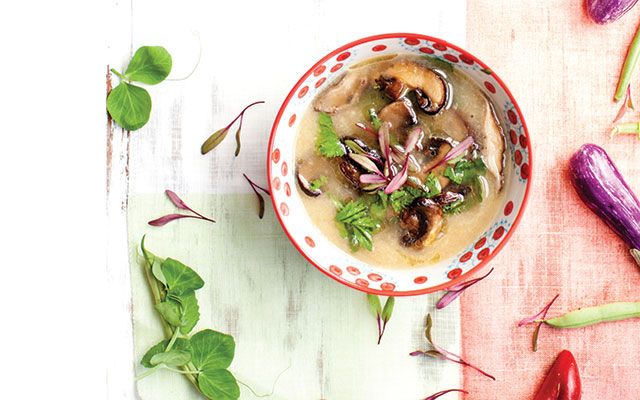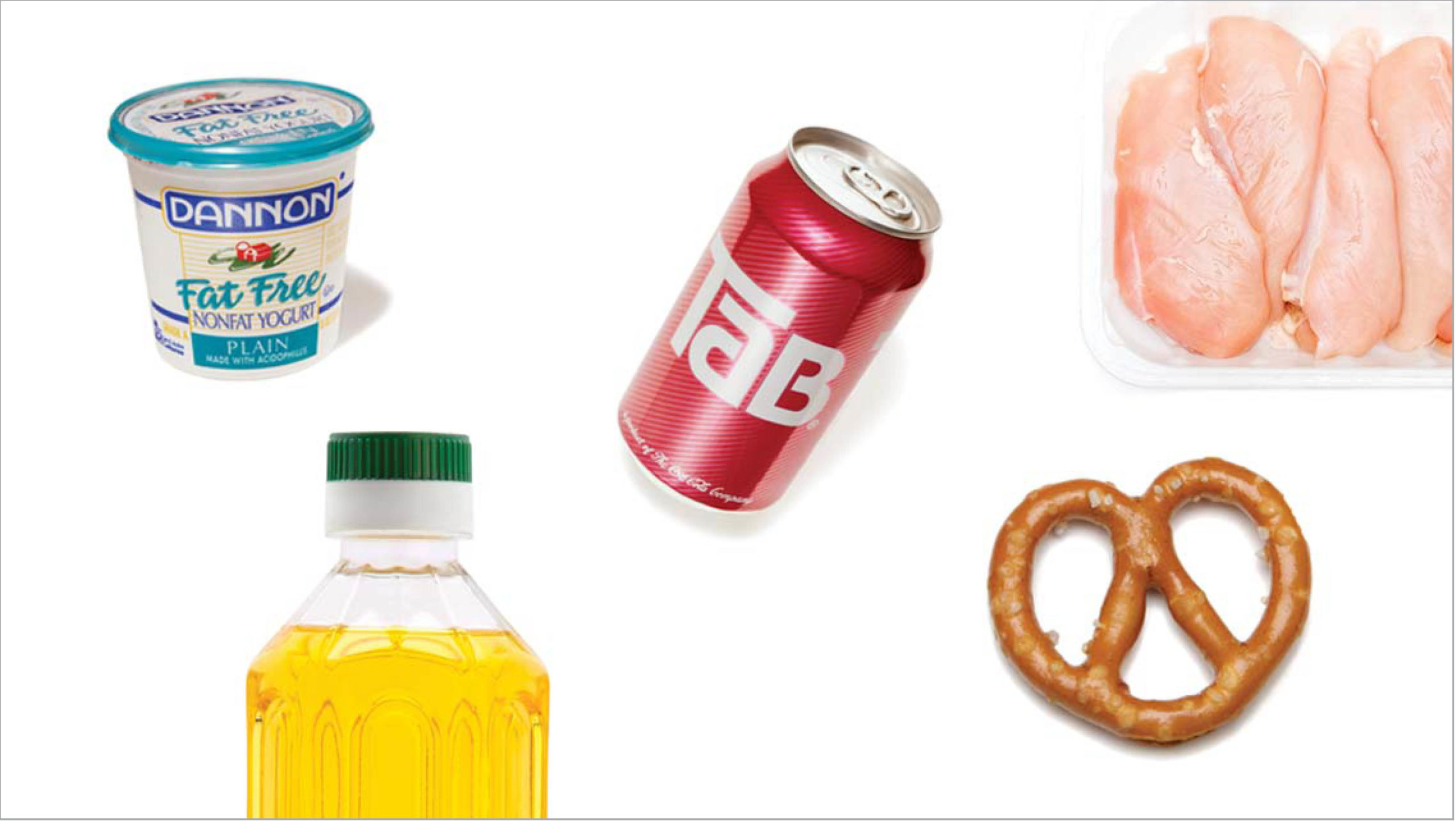When patrons at Rouge Tomate — a tony restaurant in midtown Manhattan — select the Maine lobster salad or the almond crepes, they’re getting much more than an ambrosial treat. Thanks to in-house dietitian Natalia Hancock, RD, who works closely with executive chef Jeremy Bearman, they’re also getting a nutritional powerhouse. It turns out that many dishes at Rouge Tomate are created with a focus on “food synergy,” a new type of nutritional science that emphasizes pairing nutritious ingredients to maximize their healthy benefits.
“The passion fruit vinaigrette we use on the lobster salad contains loads of antioxidants, which helps protect the structure of the omega-3 fats present in the walnuts and seafood,” says Hancock. The net result? Improved omega-3 absorption.
Indulge in the crepes for dessert, Hancock says, and the almonds’ vitamin E will safeguard the vitamin C found in the accompanying grapefruit and kumquats, extending its ability to wage protracted war on cell-damaging free radicals.
“It’s clear that certain nutrients work together to create a bigger nutritional bang with every bite,” Hancock says. “I want to make sure our customers are enjoying meals that take advantage of these powerful synergistic pairings.”
“It’s clear that certain nutrients work together to create a bigger nutritional bang with every bite.”
Over the last few decades, there has been a mountain of research on the healing powers of individual compounds in foods, such as lycopene, vitamin D and essential fatty acids. Yet, scientists are now realizing that while an antioxidant like sulforaphane in broccoli can be a potent cancer fighter on its own, combining it with another compound such as selenium found in chicken, fish and Brazil nuts, will give you even more impressive disease-fighting results.
“Food synergy ties into the prevention of so many of our chronic illnesses, including heart disease, stroke, cancer and diabetes,” says California-based dietitian Elaine Magee, MPH, RD, author of Food Synergy: Unleash Hundreds of Powerful Healing Food Combinations to Fight Disease and Live Well.
You don’t have to eat in a fancy restaurant presided over by a professional nutritionist to enjoy the benefits of food synergy, either. While researchers haven’t even begun to untangle all the science behind the synergy, these “power couples” can easily come together in your own kitchen — and prove that, when it comes to our diets, one plus one can easily equal three.
1) Adding Lemon to Tea
Green tea is at the top of the functional-drink heap, promoting wellness through antioxidants called catechins, which can aid in reducing the risk of both heart disease and cancer. But if we want a bigger health boost from our tea, we should be adding a splash of citrus, says Mario Ferruzzi, PhD, associate professor of food science at Purdue University.
“In test tube and animal studies, we discovered that ascorbic acid, such as that in citrus including lemon, orange and lime juice, helps stabilize catechins in the gut and increase absorption into the bloodstream,” he says. Looking for a warm-weather alternative? Brew up a batch of iced tea and add slices of lemon.
Other research suggests that pairing green tea with capsaicin (the compound that gives chili peppers their pow) can increase satiety and potentially aid in weight loss. The tag team of green tea and lycopene, present in watermelon, tomatoes and pink grapefruit, works synergistically to help men dodge prostate cancer.
2) The Benefits of Eating Bananas and Yogurt
Yogurt and other fermented foods, such as kefir, tempeh and sauerkraut, are teeming with beneficial live bacteria called probiotics that keep our immune and digestive systems strong. But, like all living creatures, they need something to munch on to thrive. Enter inulin.
“It behaves as a prebiotic to enhance probiotic growth.”
Found in bananas, asparagus, Jerusalem artichokes (sunchokes), onion, endive, garlic, leeks, wheat germ and artichokes, inulin is a nondigestible carbohydrate that acts as a food source for intestinal bacteria. “It behaves as a prebiotic to enhance probiotic growth,” says Georgianna Donadio, PhD, program director for the National Institute of Whole Health in Massachusetts. In addition to boosting the friendly critter count in your gut, inulin increases the intestinal absorption of bone-strengthening calcium.
3) The Role of Calcium and Vitamin D in Bone Health
If calcium could speak to vitamin D, it would say, “You complete me.” That’s because the sunshine vitamin increases the amount of calcium that gets absorbed in the intestines, says Magee. Ergo, you can down all the calcium-rich foods you want, such as tofu, yogurt, sesame seeds, broccoli and cheese, but without a steady supply of calcium’s wingman, your bones won’t reap the rewards.
If calcium could speak to vitamin D, it would say, “You complete me.”
European scientists recently reported that adequate daily consumption of both calcium and vitamin D was linked to a 20 percent drop in the rates of hip fracture in individuals 47 or older. Harvard scientists found that subjects with the highest calcium intake and blood vitamin-D levels had reduced insulin secretion, which may offer protection from type 2 diabetes. And another Harvard study determined that premenopausal women with the highest intakes of both vitamin D and calcium had a 30 percent lower risk of developing breast cancer.
Your best bet for getting enough vitamin D is to spend a minimum of 10 minutes a day in the sunshine (with a decent amount of skin exposed), but you can also benefit from good food sources, like cod liver oil, salmon and sardines. The latest recommendations from respected experts like Andrew Weil, MD — 2,000 IU of daily vitamin D — suggest that you may also need a daily vitamin-D supplement.
4) The Potential of Herbs to Fight HCSs in Red Meat
Good news for grilled-meat lovers: Scientists at Kansas State University discovered that adding rosemary and other herbs to meat cooked at high temperatures reduces the formation of suspected carcinogenic compounds called heterocyclic amines (HCAs) by as much as 70 percent. Antioxidants in extra-virgin olive oil have also been found to help fend off cancer-promoting HCAs. Similarly, marinating meat such as steak and chicken in an antioxidant-rich spice or wine blend has been shown to be a very effective method of reducing HCAs.
5) Healthy Fats in Salads
Find naked salads unbearably boring? Then, by all means, top them with vinaigrette or a sprinkle of toasted pine nuts. Similar studies from Ohio State University and Iowa State University showed that adding healthy fats like nuts, extra-virgin olive oil or avocado to your salad bowl can increase the amount of beneficial antioxidants — such as lutein in leafy greens, lycopene in tomatoes and red peppers, and beta-carotene in carrots — your body absorbs.
“Fat slows down the digestion process, which gives the plant compounds in the same meal a better chance of being absorbed.”
“Fat slows down the digestion process, which gives the plant compounds in the same meal a better chance of being absorbed,” says Magee. Fat also helps fat-soluble antioxidants, such a vitamin E, dissolve in the intestine so they can be passed into the bloodstream more efficiently. After absorption, says Magee, these antioxidants may help vanquish some of the free radicals in our bodies, which can damage DNA and trigger diseases and hasten aging.
In fact, a 2008 Journal of Nutrition study reported that those who ate more alpha- and beta-carotenes — compounds in fruits and vegetables that help bring out their stunning yellow, orange or red hues — had roughly a 20 percent lower risk of dying from heart disease over a 15-year period than those who took in less.
6) Iron and Vitamin C: The Perfect Match
Long before food synergy became part of our lexicon, scientists knew that iron and vitamin C form a unique relationship. Iron comes in two guises: heme iron, the type found in animal products such as beef, fish and poultry, and a form called non-heme, found in plant foods like beans, whole grains and spinach.
On its own, the body absorbs up to 33 percent less non-heme iron than heme iron, says Donadio, “but you can increase its absorption two- to threefold by consuming it with the vitamin C in whole fruits and vegetables.”
So how does vitamin C pull off this nifty trick? Donadio says it likely participates in the production of an enzyme responsible for changing non-heme iron to a more easily absorbed form called ferrous iron, so you get more mileage, for example, out of the iron in your bean salad. Iron is necessary for producing hemoglobin, which transports oxygen to muscles and the brain. Low levels can lead to fatigue, weakness and poor concentration. Vegans and vegetarians should take particular heed of this food pairing to help keep iron stores replete. Premenopausal women are also particularly vulnerable to iron deficiency due to losses through menstruation.
7) Fight Sodium Overload With Potassium
By all accounts, the American diet is tantamount to a salt lick. According to Centers for Disease Control data, the average person in the United States consumes an elephantine 3,436 milligrams of sodium daily, double the amount most people should ingest. For some, this is a recipe for cardiovascular woes because of a salt-induced rise in blood pressure, which raises stroke and heart-attack risk. But potassium, which encourages the kidneys to excrete sodium, can counter the harmful effects of sodium overload. So, when noshing on salty dishes or sodium-packed canned soups, frozen meals and fast-food fare, make sure to load up on potassium-plump fruits, vegetables and legumes at the same time.
8) Carbs and Protein for Muscle Recovery
If you emerge from the gym with a rapacious appetite, make sure to quell it with a healthy dose of both protein and carbohydrates. “Carbohydrates and protein together after a workout work jointly to speed up muscle recovery by enhancing the blood insulin response,” says Molly Kimball, a sports dietitian at the Elmwood Fitness Center in New Orleans. “Higher insulin levels will supply muscles with a faster and larger dose of repair nutrients such as glucose and amino acids.”
“Carbohydrates and protein together after a workout work jointly to speed up muscle recovery by enhancing the blood insulin response.”
The outcome of this perfect pairing is less muscle soreness and better fitness results. Postworkout, Kimball recommends carbohydrate and protein combinations such as a turkey sandwich, yogurt and fruit; brown rice and grilled chicken or tofu; and pasta with meat sauce.
9) Wine and Fish
Merlot and salmon may indeed be a perfect pairing. A 2008 study published in the American Journal of Clinical Nutrition reported that European men and women who consumed as little as 4 ounces of wine a day had higher blood levels of the omega-3 fats found in fish such as trout, salmon and sardines. The same results were not found for beer or spirits.
Scientists believe that heart-chummy polyphenol antioxidants in wine such as resveratrol might be responsible for the improved absorption of omega-3 fats, which have been shown to protect against myriad maladies, including depression, diabetes, mental decline and stroke.
Prefer chardonnay over merlot? According to a 2008 Journal of Agricultural and Food Chemistry study, white wine contains its own distinct polyphenol compounds that give it the same heart-protective qualities as red. You can enjoy wine with your fish or even use it to marinate your catch of the day.
Both on food labels, and in nutritional reporting, the tendency has been to trumpet one nutrient at a time. But food scientists have uncovered thousands of bioactive phytochemicals in fruits, vegetables and whole grains, says Magee, “and now they are discovering that these often work better in pairs or groups.”
What we’re learning, she says, is that extracting and isolating nutrients doesn’t work very well: “The power is in the packaging, and pills with single nutrients just can’t match the healing power of whole foods.”
The lessons of food synergy, it seems, are the same commonsense lessons we’ve been hearing for a long time now: For good health, eat a variety of whole foods — and eat them together.
Separate Lives
Alas, some couples were never meant to be. Here are three common food pairings that fail to bring out the best in either party.
Milk and Tea
A recent study in the European Heart Journal suggests you shouldn’t follow the lead of the Brits and spike your tea with milk. The scientists discovered that adding moo juice to black tea blunted its cardiovascular benefits. Casein protein in milk may bind up antioxidants in tea, rendering them less available for absorption.
Milk and Chocolate
A few studies have also found that milk can reduce absorption of flavonoids in cocoa. These flavonoid antioxidants are believed to be behind the numerous health perks, such as reduced blood pressure, attributed to dark chocolate. So choose dark chocolate over milk chocolate when possible.
Coffee and Oatmeal
“Tannins present in coffee, tea and wine are known to interfere with iron absorption, particularly the iron found in plant-based foods like oatmeal, beans and leafy greens,” says Jarod Hanson, ND. The upshot is this: If you’re prone to iron deficiency, you might want to avoid the cup of joe with your morning oats.
This article originally appeared as “How to Take Advantage of Food Synergies.”





This Post Has 0 Comments